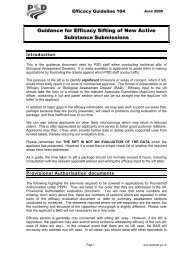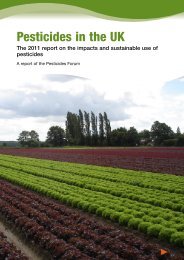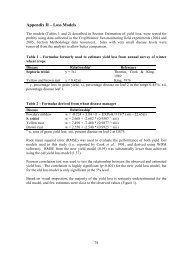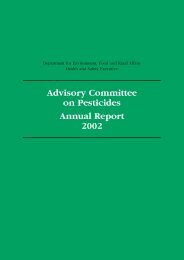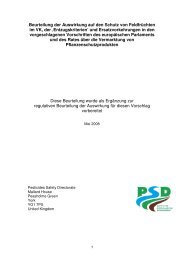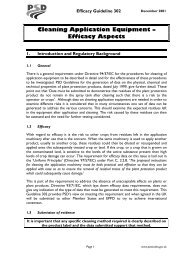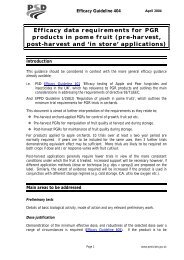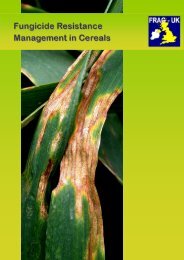Advisory Committee on Pesticides Annual Report 2001
ACP Annual Report 2001 - Pesticides Safety Directorate
ACP Annual Report 2001 - Pesticides Safety Directorate
Create successful ePaper yourself
Turn your PDF publications into a flip-book with our unique Google optimized e-Paper software.
<str<strong>on</strong>g>Advisory</str<strong>on</strong>g> <str<strong>on</strong>g>Committee</str<strong>on</strong>g> <strong>on</strong> <strong>Pesticides</strong> <strong>Annual</strong> <strong>Report</strong> <strong>2001</strong><br />
in the literature. Therefore, the <str<strong>on</strong>g>Committee</str<strong>on</strong>g> agreed that it had no c<strong>on</strong>cerns in<br />
this respect and that no further data should be required at this stage.<br />
The estimated exposures from initial handling of the product and c<strong>on</strong>tinued<br />
residential use gave no cause for c<strong>on</strong>cern. The <str<strong>on</strong>g>Committee</str<strong>on</strong>g> c<strong>on</strong>sidered that the<br />
assessment for c<strong>on</strong>tinued residential exposure should assume use in at least<br />
two rooms. This did not identify any cause for c<strong>on</strong>cern.<br />
The acute exposure estimated to occur following accidental ingesti<strong>on</strong> of the<br />
entire product by infants or children did give cause for c<strong>on</strong>cern. However,<br />
data from the Nati<strong>on</strong>al Pois<strong>on</strong>s Informati<strong>on</strong> Service (NPIS) <strong>on</strong> incidents<br />
involving these products provided some reassurance that the likelihood of<br />
this occurring was low.<br />
54<br />
Overall, the <str<strong>on</strong>g>Committee</str<strong>on</strong>g> c<strong>on</strong>cluded that approval for the two products<br />
should c<strong>on</strong>tinue subject to the companies redesigning products to include a<br />
mechanism to prevent skin c<strong>on</strong>tact when attaching them to windows, more<br />
secure adhesi<strong>on</strong> to windows, both products c<strong>on</strong>taining a bittering agent, and<br />
informati<strong>on</strong> <strong>on</strong> changes in azamethiphos c<strong>on</strong>tent during the lifetime of the<br />
product. These recommendati<strong>on</strong>s would ensure that the risk of acute exposure<br />
by c<strong>on</strong>tact or ingesti<strong>on</strong> was acceptably low. C<strong>on</strong>tinued approval was also<br />
subject to further data requirements.<br />
CCA<br />
Copper chrome arsenic (CCA) wood preservatives c<strong>on</strong>tain arsenic pentoxide,<br />
hexavalent chromium (chromium trioxide or sodium dichromate) and copper<br />
(II) oxide or copper (II) sulphate. They are supplied as pastes or water-based<br />
c<strong>on</strong>centrates which are diluted to between <strong>on</strong>e percent and ten percent w/w<br />
total salts and used in the industrial vacuum-pressure impregnati<strong>on</strong> of timber.<br />
The <str<strong>on</strong>g>Committee</str<strong>on</strong>g> had c<strong>on</strong>sidered a review of the use of CCA in industrial wood<br />
preservati<strong>on</strong> in September 1999. It had agreed that approval for CCA products<br />
could be allowed to c<strong>on</strong>tinue, subject to a number of c<strong>on</strong>diti<strong>on</strong>s and<br />
requirements, including the provisi<strong>on</strong> of specific envir<strong>on</strong>mental data.<br />
The <str<strong>on</strong>g>Committee</str<strong>on</strong>g> now c<strong>on</strong>sidered the approval holders’ resp<strong>on</strong>ses to the<br />
envir<strong>on</strong>mental data requirements, which had previously been c<strong>on</strong>sidered by<br />
its Envir<strong>on</strong>mental Panel. The <str<strong>on</strong>g>Committee</str<strong>on</strong>g> agreed that the exposure scenario<br />
proposed by approval holders was an acceptable alternative to HSE’s previous<br />
exposure scenario. However, it noted that this scenario assumed good<br />
practice, of which the British Wood Preserving and Damp Proofing Associati<strong>on</strong><br />
(BWPDA) voluntary code of practice was c<strong>on</strong>sidered to be an appropriate<br />
benchmark. The <str<strong>on</strong>g>Committee</str<strong>on</strong>g>’s Envir<strong>on</strong>mental Panel had identified several




